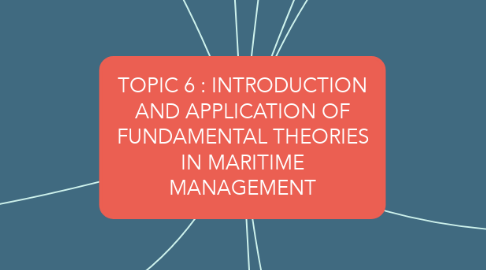TOPIC 6 : INTRODUCTION AND APPLICATION OF FUNDAMENTAL THEORIES IN MARITIME MANAGEMENT
by Afza Najwa Binti Zulkefli

1. MARITIME
2. Connected with the ocean in relation to navigation, shipping, etc.
3. PRINCIPAL OCEAN AND ACTIVITIES
4. Navigation and communication eg. shipping, cables construction etc.
5. Living marine resources
6. Mineral and energy resources
7. Tourism and recreation
8. Coastal infrastructure development
9. Waste disposal and pollution prevention
10. Ocean and coastal environment quality protection eg. Marine mammals
11. Beach and shoreline management. eg. erosion control program.
12. Military activities, naval, enforcement
13. Research eg. Oceanography, marine sciences.
14. OCEANOGRAPHY
15. Geology
15.1. Sea floor tectonics coastal processes sediments hydrologic cycle
16. Geography
16.1. Wind belts weather coastal landforms world climate
17. Biology
17.1. Fisheries ecological surveys microbiology marine adaptations
18. Chemistry
18.1. Dissolved components temperature dependence stratification / density chemical tracers
19. Physic
19.1. Currents, waves, sonar thermal properties of water.
20. Astronomy
20.1. Tidal forces oceans on other planets origin of water origin of life
21. IMPORTANCE OF MARITIME INDUSTRY
22. Plays a very significant role in the socio-economic
23. Eco - friendly
24. Vital for national security
25. Provide a huge occupational industry for mankind
26. AREAS UNDER NATIONAL JURISDICTION
27. Internal waters
27.1. 3 nautical miles
28. Territorial waters
28.1. 12 nautical miles
29. Exclusive economic zones
29.1. 200 nautical miles
30. Under national outlined
31. IMPORTANCE OF THE OCEAN
32. Harbor a tremendouswealth of living and non- living things
33. Fisheries as source of protein
34. Petroleum and gas from sea propel country's growth as energy resources
35. A host for many activities
36. ECONOMIC IMPORTANCE OF LIVING RESOURCES
37. Fish
37.1. Fisheries Resources
38. Marine Mammals
38.1. Ecotourism (Whale watching)
39. Turtle
39.1. Ecotourism (turtle wathcing)
40. Corals
40.1. Ecotourism (diving)
41. Seaweed
41.1. Pharmaceutical and food product
42. Algae
42.1. Pharmaceutical and food product
43. ECONOMIC IMPORTANCE OF NON-LIVING RESOURCES
44. Hydrocarbons (e.g. oil and gas)
44.1. Petroleum, methane hydrates
45. polymetallic sulphides
45.1. Copper, lead, zinc, silver and gold
46. Manganese nodules
46.1. Production of steel industry
47. Sand and gravel
47.1. Construction aggregates (e.g. buildings and highways)
48. Phosphorites
48.1. Fertilisers and chemical products
49. Bromin
49.1. Gasoline antiknock compound, fumigants, flame retardant, pharmaceuticals, biocides and pesticides
50. MARITIME INDUSTRIES
51. Shipping & related industry
52. Fishing industry
53. Petroleum and gas industry
54. Tourism industry
55. OTHERS AREAS
56. Boat / ship manufacture & repair industry
57. Food manufacture (sea produce) industry
58. Sea activities related equipment manufacture industry
59. Skills training industry (manpower for sea activities / work at sea


